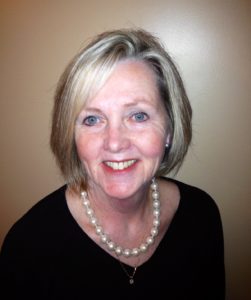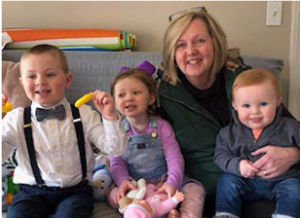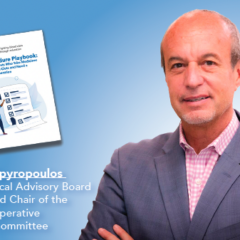Last updated on
Titan of Thrombosis: Ruth Morrison
Our Titans of Thrombosis series honors advocates and experts in the thrombosis field and showcases their important contributions.

Ruth Morrison is a clinical research nurse and has worked at the Brigham and Women’s Hospital (BWH) Thrombosis Research Group (TRG) for 33 years. She began her nursing career at BWH in 1976. Prior to forming TRG, cardiac nursing was her main interest. Ruth has been involved in numerous clinical trials focusing on the prevention, diagnosis, and treatment of blood clots. She’s also been active in NATF for over a decade and devotes much of her time to educating and advocating for patients.
Q: Tell us about yourself.

I’ve been married for 36 years and have three children and a step- daughter. As of last month, I have four grandchildren. (One was just born in March!) I retired from clinical nursing in April 2019 but still work part-time as a research nurse. My husband and I love to travel and spend time with our family. I got my real estate license four years ago and hope to use it more when I have some spare time.
I’ve worked at BWH my entire career. I started in the medical-surgical unit and then became the charge nurse in the coronary care unit (CCU), which is where patients go when they have a serious heart condition and require 24/7 monitoring. I don’t know what exactly drew me to the CCU. I was young, I loved taking care of seriously ill patients, and it just seemed like a natural fit. In 1996, I got my certification in vascular nursing.
Q: What is vascular nursing?
Vascular nurses work with patients who have (or are at risk for) conditions that affect the blood vessels, like blood clots, atherosclerosis, peripheral artery disease, etc. Many of us do clinical work, research, and patient education.
When I started my nursing career, I didn’t consciously realize that I was choosing vascular medicine – but I fell in love with it.
Q: You’ve been working at TRG, the Thrombosis Research Group at BWH, for more than 30 years. What is TRG and what’s your role there?
TRG addresses the medical and psychological care of patients who have cardiovascular (CV) diseases, like blood clots, atrial fibrillation, and coronary artery disease. During my time at TRG, I’ve worked on many clinical trials. I’ve helped recruit, screen, and enroll patients in trials and I’ve implemented lots of study protocols. If patients were hospitalized, I’d handle the inpatient, discharge, and follow-up processes. We’d all work as a team to make sure the study protocol was carried out appropriately, and depending on the study, we’d follow these patients for years!
Q: What have you enjoyed most in your research role?
It’s gratifying to see how our work impacts medical practice. Some of the trials I’ve worked on have dramatically changed how we manage blood clots and other CV diseases. One of the most memorable trials looked at the use of an anticoagulant injection called low-molecular-weight heparin (LMWH) for blood clot treatment. This was a groundbreaking study because we found that patients with blood clots could go home and self-administer LMWH instead of being admitted to the hospital.
Q: What should patients know about a clinical trial if they haven’t participated in one before?
The purpose of a clinical trial is to see if there’s a treatment that’s potentially better than the therapies we’re already using. We can’t figure that out without the help of our patients – and likewise, lots of patients want to be a part of medical advancement. But people should know that once they consent to being in a trial, they don’t need to stay the course if they’re uncomfortable. They can always withdraw consent. I don’t think people always realize that about research protocols.
To comply with study protocols, we watch patients closely and are always available to them. A huge part of the research process is providing support to participants.
Q: And outside of the clinical trial realm, you’ve provided support to hundreds of patients. You and NATF’s president, Dr. Goldhaber, launched a blood clot support group almost 30 years ago. Tell us about that.
After having a blood clot, patients would come into the clinic with such a high anxiety level because they had no idea what was going on in their lives. Many patients had never heard of deep vein thrombosis (DVT) or pulmonary embolism (PE) and thought they might die. We’d spend a while counseling them, but then our clinic schedule would fall behind. So, we thought it would be nice if patients had a way to get medical information and emotional support, and the Boston PE/DVT Support Group was born. It’s a great way to raise awareness about clots and it helps blood clot survivors feel less alone.
We still meet monthly and typically split the meeting into two parts. First, we explain “blood clot basics” in lay terms and provide patients with insight into current trials, research, and guidelines. Then, we ask patients to share their stories, and we offer strategies for managing their anxiety.
Q: What’s been the most important thing you’ve learned in your career?
I’ve learned compassion beyond belief. As a nurse, your priority is to keep people alive (or care for them when they’re dying), help them maintain autonomy, work with them to manage stress, and care for them like you’d care for a family member. I’ve had moments every day in my career that I’ll remember for the rest of my life, and I’m so grateful for those experiences.
*Originally published in The Beat – April 2020. Read the full newsletter here.



